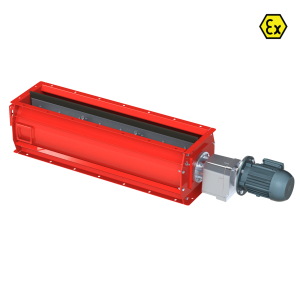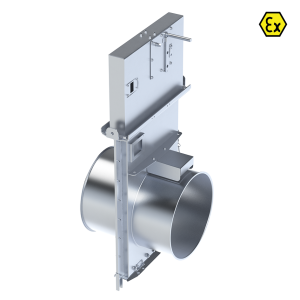Insights of dust extraction industry
ATEX Directives & Safety
Dust extraction components are widely known for their vast applicability capabilities. Some form of dust and other material extraction is an integral part of most production facilities across the globe. Formula Air has completed various projects in a multitude of industries, such as wood, recycling, metal, paper, paint, plastic, and many more. In these industries, the production process often generates combustible dust and other particles which can pose a significant safety hazard to workers and equipment. Therefore, it's important to have proper safety measures in place, including the implementation of the ATEX Directives.
ATEX Explained
The ATEX Directives is a set of regulations that originated in the European Union in 1994. The Directive's aim is to ensure the safety of employees, installations and surroundings in potentially explosive atmospheres. ATEX stands for "ATmosphères EXplosibles," which translates to "explosive atmospheres" in English. The ATEX Directives outline the general safety requirements for equipment and protective systems intended for use in hazardous areas, and it also provides guidance on how to classify these areas.
ATEX area classification is the process of identifying and categorizing areas that have a risk of explosion due to the presence of combustible dust, gases or hybrid mixtures. The classification system consists of three levels, Level 1 for Zones 0/20 Level 2 for Zones 1/21 and Level 3 for Zones 2/22 with Zones 0/20 being the highest risk and Zone 2/22 being the lower risk.
Zone 0/20
Refers to areas where an explosive atmosphere is present continuously or for long periods.
Figures:
> 1000 hours/year or more than 10% of the time.
Zone 1/21
Refers to areas where an explosive atmosphere is likely to occur during operations.
Figures:
10 - 1000 hours/year or between 0,1% and 10% of the time.
Zone 2/22
Refers to areas where an explosive atmosphere is not likely to occur in normal operations.
Figures:
< 10 hours/year or less than 0,1% of the time.
Is it enough just to comply with ATEX regulations?
While the ATEX Directives provide a framework for ensuring safety in hazardous areas, it is important to note that local or national legislations define the exact parameters that the user has to abide to in function of the type of installation he communicated he was planning to develop. However, the user may decide to go beyond these requirements by implementing additional measures to increase the safety level of the employees and equipment.
Keep in mind that storage spaces and productions implementing ATEX regulations must take a comprehensive approach to safety, including ongoing risk assessments, regular equipment maintenance, and adequate training for employees.
Additionally, the ATEX Directives only provide guidance on how to classify hazardous areas based on the risk of explosion and define general safety parameters that need to be observed. They do not define specific equipment to be used in these installations. It is up to the installer to see which explosion suppression systems, fire extinguishing systems, and ventilation systems best meet all the requirements to reduce the risk of explosions and minimize damage in case of an explosion or fire.Guidance on how to classify hazardous areas based on the risk of explosion. It does not provide specific guidance on how to mitigate these risks or prevent explosions. Therefore, organizations can implement additional safety measures such as explosion suppression systems, fire extinguishing systems, and ventilation systems if they want to further reduce the risk of explosions and minimize damage in case of an explosion or fire.

Combining ATEX with safety measures
There are various additional safety measures that installers can take to increase safety beyond the minimum requirements set by the ATEX Directives. We can condense all measures into 2 separate categories - Preventative or Mitigation measures.
By implementing a combination of both preventative and mitigation measures, companies can significantly reduce the risk of explosions and fires in hazardous areas and ensure the maximum safety of their employees and equipment.
Preventative Measures
Focus on preventing or reducing the likelihood of an explosion occurring in a hazardous area.
- Risk Assessment
Conducting a comprehensive risk assessment is the first step towards identifying potential explosion hazards in a workplace. This includes identifying all possible sources of combustible dust, and gases and evaluating their potential to ignite and cause explosion. This identification allows to remove or contain them in the most effective way. The sources that cannot be contained should be further assessed - measure the impact of a possible explosion and implementthe appropriate safety measures where applicable.
- Equipment Maintenance
Proper equipment maintenance is critical in preventing accidents in hazardous areas. Regular inspections, cleaning, and repairs of equipment and tools such as dust collectors, ventilation systems, and electrical systems can prevent malfunctions that can lead to explosions.
- Employee Training
Adequate training for employees working in hazardous areas is also crucial. Employees must be trained on the risks of working in these areas, how to use safety equipment, and how to respond in case of an emergency.
Mitigation Measures
Focus on reducing the impact of an explosion or fire if it does occur.
- Explosion Isolation Systems
Explosion Isolation systems can be installed to prevent or mitigate the propagation of an explosion.
- Fire isolation and extinguishing systems
Fire isolation and extinguishing systems detect, separate and extinguish fire sources (spark, amber, etc.) before they spread.
- Explosion Venting Systems
Venting systems are designed to relieve pressure build-up from an explosion, reducing the risk of damage to equipment and personnel.
Benefits of additional safety measures
While implementation of additional safety measures might be somewhat time-consuming and require additional cost, it brings a substantial amount of benefits, such as:
- Reduced risk of accidents
Implementing additional safety measures reduces the risk of accidents in hazardous areas, protecting personnel, equipment, the environment, and surrounding buildings.
- Reduced damage and loss
Explosion protection and fire suppression systems can significantly reduce the damage caused by an explosion or fire.
- Improved equipment lifespan
Regular maintenance and proper use of equipment can prolong its lifespan, reducing the need for costly replacements.
- Increased productivity
A safer work environment can improve productivity by reducing downtime and the need for repairs, allowing employees to focus on their tasks with greater peace of mind.
- Reputation
Demonstrating a commitment to safety can enhance an organization's reputation with customers, partners, and stakeholders.
- Business continuity
Preventing accidents and minimizing the impact of an explosion can reduce downtime, ensuring that the business can continue operating and minimizing revenue loss.
Explore our complete ATEX & Safety product range
Conclusion
We hope that this article has provided you with a significantly enhanced comprehension of the ATEX directive and the paramount significance of safety within the dust extraction industry. Although this subject matter can be intricate, encompassing various crucial aspects, it is imperative to grasp its essence in order to maintain a leading position in this industry. With our extensive experience of over 30 years as experts in the dust extraction sector, we are dedicated to assisting you not only through the provision of exceptional dust extraction components but also by sharing our wealth of knowledge and expertise. If you have any further questions or wish to collaborate with us on your upcoming ATEX project, we warmly encourage you to reach out to us. Our team is readily available to offer support and guidance.






